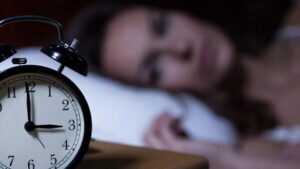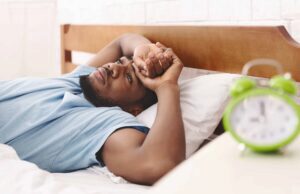Narcolepsy
Disclosure: By clicking on the product links in this article, Mattress Nerd may receive a commission fee at no cost to you, the reader. Read full disclosure statement.
Mattress Nerd consulted Dr. Alaina Rajagopal, MD, PhD to ensure that this article met our editorial standards
Narcoleptics have gotten a bad rap, often getting accused of being lazy. If you’ve seen movies like My Own Private Idaho, Deuce Bigalow: Male Gigolo, or, most recently, Ode to Joy, you may also assume someone with the condition suddenly collapses during normal activity into peaceful sleep. In reality, narcolepsy is a much more complex and life-disrupting condition than most people realize.
Narcolepsy is a largely misunderstood chronic sleep disorder. People with the condition experience overwhelming daytime drowsiness and sudden attacks of sleep. It affects about 1 in 2,000 people, but because the disorder often goes unrecognized or misdiagnosed, it’s likely the incidence is much higher, according to the National Organization for Rare Disorders.
Depending on its severity, narcolepsy can be debilitating, impacting daily activities and even affecting your sleep. There is no cure for narcolepsy, but there are strategies that can help you manage your condition.

What is Narcolepsy?
Narcolepsy affects a person’s sleep-wake cycle. Those with the condition may awaken frequently at night. And while they may wake in the morning feeling rested, they can become excessively sleepy as the day progresses. When these sleep attacks occur, they may suddenly drop off to sleep during daily activities, like walking, talking or even driving. Their bodies go limp, they become paralyzed, and they can experience vivid dreams or hallucinations.
There are three types of narcolepsy:
- Type 1 Narcolepsy: is defined as having excessive daytime sleepiness with cataplexy, a sudden loss of muscle tone while a person is awake. It can also be diagnosed based on low levels of the brain hormone hypocretin.
- Type 2 Narcolepsy: is defined by excessive daytime sleepiness but without the episodes of muscle weakness.
- Secondary Narcolepsy: This rare type of narcolepsy can occur if there is an injury to the small region of the brain called the hypothalamus. People with secondary narcolepsy may also have severe neurological problems and sleep more than 10 hours at night.
Narcolepsy is a lifelong problem, and there is no cure. But the promising news is that symptoms rarely worsen as one gets older and in some cases symptoms can improve over time.
Symptoms of Narcolepsy
Narcolepsy is associated with the following symptoms, according to the National Institute of Neurological Disorders and Stroke:
- Excessive daytime sleepiness. All individuals with narcolepsy experience excessive daytime sleepiness, which is characterized by persistent sleepiness regardless of how much sleep a person gets. But the sleepiness associated with narcolepsy is more like a “sleep attack,” where the person is suddenly overcome by sleepiness.
- Cataplexy. Cataplexy is a sudden loss of muscle tone while a person is awake which leads to weakness and a loss of voluntary muscle control. It’s often triggered by sudden, strong emotions such as laughter, fear, anger or stress. Some people with narcolepsy may have one or two cataplexy attacks in their lifetime while others can have several attacks a day. The severity can vary as well with mild attacks only causing a momentary sense of weakness while severe cases can cause someone’s entire body to collapse. Even during the most severe cataplexy attacks, the individual remains fully conscious, which distinguishes narcolepsy with cataplexy from fainting or a seizure. Episodes only last a few minutes, but they can be quite frightening to experience or witness.
- Sleep paralysis. The body temporarily loses its ability to move or sleep when in REM sleep. This prevents someone from acting out their dreams which could be dangerous. Those with narcolepsy, however, can experience sleep paralysis when falling asleep or waking up, as well as during sleep attacks.
- Hallucinations. People with narcolepsy may have visual hallucinations when falling asleep or waking up. In some cases, other senses may be involved.
- Disrupted nighttime sleep and insomnia. You’d think someone who is excessively sleepy during the day would drift off peacefully at night. But that couldn’t be farther from the truth. People with narcolepsy often experience insomnia and fragmented sleep during the night due to vivid dreams, sleep apnea, acting out dreams, or moving their limbs periodically.
- Automatic behaviors. During habitual activities, such as walking or talking, someone with narcolepsy may experience temporary sleep episodes during which they may automatically continue the activity for a few seconds or minutes without conscious awareness of their actions. Their activity will also be impaired during these episodes. For example, if they are writing, their penmanship may turn into scribbles. This can be an especially dangerous symptom during activities such as driving.
Causes of Narcolepsy
It’s not fully understood what causes narcolepsy, but research suggests there could be several factors at play.
- Autoimmune disorders: Nearly all people with Type 1 Narcolepsy, the form of the sleep disorder with cataplexy, also have extremely low levels of hypocretin, a chemical produced by the brain that helps you feel alert and awake while also regulating REM sleep. Researchers believe this dip in hypocretin levels may be due to an autoimmune disorder that prompts the immune system to attack hypocretin cells.
- Family history: While most narcoleptics aren’t aware of any family members with the same condition, up to 10 percent of those with Type 1 Narcolepsy report having a close relative with similar symptoms.
- Age: Narcolepsy symptoms can surface anytime from early childhood into late adulthood. But two peak time periods for onset have been identified — around 15 years of age, and around 36 years of age.
- Brain injuries: In rare cases, secondary narcolepsy can occur in individuals who have suffered a traumatic injury, tumor, or disease in the small region of the brain called the hypothalamus.

Managing Narcolepsy
Narcolepsy is a chronic neurological disorder that can greatly affect daily activities. If left undiagnosed or untreated, it can have an adverse impact on all areas of your life. It can even interfere with your sleep. While there is no cure for narcolepsy, symptoms can be managed, sleep improved and quality of life restored with interventions such as medications, improved sleep hygiene and lifestyle changes.
Medications
While there is no cure for narcolepsy, some medications can help ease symptoms of excessive daytime sleepiness and cataplexy:
- Modafinil. This first-line narcolepsy treatment, known by the brand name Provigil, is a stimulant that helps reduce extreme sleepiness and promote wakefulness.
- Amphetamine-like stimulants. Stimulants like methylphenidate (Daytrana) are sometimes prescribed to fight daytime sleepiness. But they also carry concerning side effects including irritability, nervousness, shakiness and heart arrhythmias, and may also disrupt sleep. Amphetamines also have a high potential for abuse.
- Antidepressants. Two different classes of antidepressants have been found to effectively control cataplexy — tricyclics such as imipramine, desipramine, clomipramine and protriptyline, and selective serotonin reuptake inhibitors (SSRIs) such as venlafaxine (Effexor XR) and fluoxetine (Prozac).
- Sodium oxybate. Also known as gamma hydroxybutyrate or GHB, sodium oxybate is a depressant that acts on the central nervous system. It’s prescribed under the brand name Xyrem, and can treat both cataplexy and excessive daytime sleepiness. GHB is a strong sedative, which makes it highly controversial. It’s also referred to as a “club drug,” and as a result its use is tightly restricted.
Practicing Good Sleep Hygiene
Establishing good sleep hygiene is a critical part of managing narcolepsy symptoms.
Keep a sleep diary. Journaling about your sleep can help you and your doctor identify issues that may be interfering with your sleep or worsening your daytime narcolepsy symptoms. Information to record in a sleep diary includes:
-
- What time you went to bed and woke up.
- How many hours you slept uninterrupted.
- Any nighttime awakenings.
- Any medications, which may reveal side effects that impact sleep quality.
- Food or beverages you consumed during the day and when, including alcoholic beverages.
- Any stressors during the day that may impact sleep.
- Any exercise you engaged in during the day and when.
Maintain a consistent sleep schedule. Establishing a regular bedtime and wake time can help you fall asleep at bedtime and wake feeling refreshed.
Take short, regularly scheduled naps throughout the day. When you feel overly sleepy during the day, settling down for a short nap may help you feel more alert when awake.
Implement a nighttime routine that works for you. Plan a routine about 30 minutes before bedtime to help prepare your body and mind for sleep. Take a warm bath or shower, read or listen to music, or practice meditation or relaxation exercises.
Avoid blue light close to bedtime. Smartphones, laptops, televisions, tablets — they all emit blue light, which elevates mood and cognitive function. It’s great during the day when you want to focus. But it can make falling asleep at bedtime difficult.
Avoid alcohol before bedtime. A glass of wine or two may be nice before bedtime. After all, alcohol is a sedative and can help you fall asleep quickly. But it can also interfere with restorative REM sleep and leave you wide awake in the wee hours.
Avoid nicotine and caffeine close to bedtime. You may want to reconsider that soda or cigarette before bedtime. Both caffeine and nicotine are stimulants and can keep you up at night when you’re trying to fall asleep.
Exercise daily. At least 20 minutes of exercise each day can do wonders for your sleep. But be sure to do it a few hours before bedtime so it doesn’t hinder your sleep. Exercise releases endorphin, the “feel good” hormone, which peps you up instead of settling you down.
Experiment with foods that make you feel more or less alert. What you eat can actually affect your sleep and wakefulness. Experiment with different foods, and record them in your sleep journal to see how they might affect your sleep. For example, foods that promote alertness include electrolyte-packed bananas, vitamin-charged spinach, and omega-3-loaded fish. Foods that encourage sleep include protein-rich nuts and complex carbohydrates like breads, cereals and pasta.
Other Lifestyle Considerations
- Be open about your condition with those you trust. Talking about narcolepsy and your symptoms can help educate your friends about what to expect if you suffer an attack in their presence. It will also give them some insight into your struggles, and help lighten your emotional load.
- Consider talking with your employer about your condition. According to the Americans with Disabilities Act (ADA), employers are required to make any workplace accommodations for those with narcolepsy. For example, you can ask your employer to allow time and space for you to take brief naps during the day, or schedule more demanding tasks at times when you feel more alert.
- For school children with narcolepsy, create a plan with the school administration, because children are also protected by ADA. For example, ask the school if your child can take breaks to nap at the nurses office, swap a desk chair with an exercise ball to promote wakefulness, or even chew gum in class to keep them stimulated.
Where is Narcolepsy Research Today?
There have been great strides in narcolepsy research in recent decades. Scientists better understand the condition and have identified genes likely to be associated with the condition. For example, researchers have found that a loss of hypocretin-producing neurons in the hypothalamus is the primary cause of Type 1 narcolepsy. These cells help stabilize sleep and wake states. Without them, spontaneous changes can occur with wakefulness, REM sleep and non-REM sleep. But why these hypocretin neurons die remains a mystery.
Emerging research funded in part by the National Institutes of Health (NIH) suggests immune system abnormalities may be to blame, in particular, the immune-system-regulating gene called the human leukocyte antigen, or HLA. Some people with narcolepsy have variations in certain genes that increase their chance of developing narcolepsy, particularly Type 1 narcolepsy with cataplexy. But, these gene variations are common in much of the population but only a few with this gene variation go on to experience symptoms of narcolepsy. Why? Researchers believe other genetic or environmental factors may play a role.
Some researchers also think that narcolepsy could be an immune response to a recent bacterial infection such as strep throat or even the H1N1 “swine flu” epidemic of 2009.
To better understand the causes of the condition, research on narcolepsy is focused on three specific areas — genetics and biochemicals, the immune system, and sleep biology, such as investigating how the brain’s circuits function in the body and contribute to sleep disorders like narcolepsy.
Final Thoughts
Narcolepsy is a chronic sleep disorder that affects about 135,000 to 200,000 people in the United States, according to the National Institute of Neurological Disorders and Stroke. But the number is likely higher, as the condition often goes unreported and undiagnosed. It can be a debilitating condition that can affect all aspects of life, inhibiting your academic, work and social activities, and disrupting your sleep. But it is possible to manage narcolepsy symptoms with medication, sleep hygiene improvements and lifestyle changes, and live a full life with your sleep disorder.



